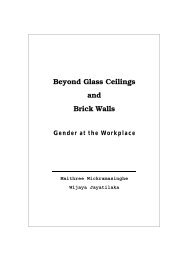SETP No. 14 The Economic Value of Incremental Employment in the ...
SETP No. 14 The Economic Value of Incremental Employment in the ...
SETP No. 14 The Economic Value of Incremental Employment in the ...
You also want an ePaper? Increase the reach of your titles
YUMPU automatically turns print PDFs into web optimized ePapers that Google loves.
practical feasibility alone, labour can be fully substituted for equipment <strong>in</strong> <strong>the</strong><br />
great majority <strong>of</strong> civil works projects. <strong>The</strong> orig<strong>in</strong>al diamond m<strong>in</strong>e at Kimberley is<br />
one <strong>of</strong> many domestic examples <strong>in</strong> <strong>the</strong> m<strong>in</strong><strong>in</strong>g <strong>in</strong>dustry <strong>of</strong> <strong>the</strong> extent to which this<br />
was - hence (<strong>in</strong> practical terms) still is - possible.<br />
1.5 <strong>The</strong> key issue, <strong>the</strong>refore, is not what <strong>the</strong> technical boundaries may be for <strong>the</strong><br />
substitution <strong>of</strong> labour for equipment. It is ra<strong>the</strong>r a matter <strong>of</strong> (a) when it makes<br />
f<strong>in</strong>ancial sense to do so, and (b) when <strong>the</strong> overall economic benefit <strong>of</strong> <strong>in</strong>creased<br />
employment, may outweigh any f<strong>in</strong>ancial premium paid for a given output.<br />
F<strong>in</strong>ancial Limits for Labour Substitution<br />
1.6 <strong>The</strong> f<strong>in</strong>ancial boundary to <strong>the</strong> substitution <strong>of</strong> labour for equipment <strong>in</strong> construction<br />
can be set quite simply and clearly. It is that <strong>the</strong> enhancement <strong>of</strong> employment<br />
should not lead to a higher cost for a given construction output than for any o<strong>the</strong>r<br />
balance <strong>of</strong> labour and equipment <strong>in</strong>puts. <strong>The</strong> ma<strong>in</strong> issues at stake are <strong>the</strong> cost <strong>of</strong><br />
labour per unit output and associated management and supervision costs.<br />
1.7 As noted, it is practically feasible for <strong>the</strong> complete substitution <strong>of</strong> labour for<br />
mechanised equipment <strong>in</strong> most civil eng<strong>in</strong>eer<strong>in</strong>g projects. It is even possible to<br />
achieve adequate compaction <strong>of</strong> earth <strong>in</strong> roadwork’s us<strong>in</strong>g labour-<strong>in</strong>tensive<br />
methods. <strong>The</strong> problem is, however, that <strong>the</strong> amount <strong>of</strong> effort required - <strong>the</strong> workday<br />
<strong>in</strong>puts, hence <strong>the</strong> costs - are usually so high that compaction by hand is<br />
rarely even considered.<br />
1.8 In sum, <strong>the</strong> f<strong>in</strong>ancial limit for substitut<strong>in</strong>g labour for equipment <strong>in</strong> construction is<br />
set by <strong>the</strong> lowest price for which <strong>the</strong> very same output could be produced by<br />
means <strong>of</strong> any o<strong>the</strong>r balance <strong>of</strong> factor <strong>in</strong>puts.<br />
1.9 <strong>The</strong> 'Big Hole' at Kimberley <strong>in</strong>volved <strong>the</strong> manual excavation <strong>of</strong> <strong>in</strong> <strong>the</strong> order <strong>of</strong> 60<br />
million tonnes <strong>of</strong> solid rock. This was <strong>the</strong>n carefully crushed and washed - aga<strong>in</strong><br />
by hand - yield<strong>in</strong>g about 45 grams <strong>of</strong> diamonds per thousand tonnes excavated.<br />
<strong>Economic</strong> Limits for Labour Substitution<br />
1.10 <strong>The</strong> economic limits for substitut<strong>in</strong>g labour for equipment are more complex. <strong>No</strong>t<br />
only are <strong>the</strong> economics <strong>the</strong>mselves complicated, but labour substitution as a<br />
whole raises complex political issues, particularly <strong>in</strong> South Africa. <strong>The</strong>re are two<br />
broad fronts on which economic valuation is required:<br />
i) <strong>the</strong> economic benefit <strong>of</strong> <strong>in</strong>cremental employment:<br />
ii) <strong>the</strong> economic cost (or benefit) <strong>of</strong> us<strong>in</strong>g equipment.<br />
<strong>The</strong> <strong>Economic</strong> <strong>Value</strong> <strong>of</strong> <strong>Employment</strong><br />
1.11 Keynesian <strong>the</strong>ory emphasises that <strong>in</strong> conditions <strong>of</strong> high unemployment, hence<br />
broadly depressed demand for goods and services, employment-<strong>in</strong>tensive<br />
construction programmes not only support <strong>the</strong> subsistence <strong>of</strong> those engaged.<br />
<strong>The</strong>y have wider beneficial effects <strong>in</strong> two ma<strong>in</strong> directions:<br />
i) <strong>the</strong> wages earned give <strong>in</strong>creased purchas<strong>in</strong>g power among <strong>the</strong> direct beneficiaries<br />
(and <strong>in</strong> turn, <strong>the</strong>re are beneficial multiplier effects among <strong>the</strong> <strong>in</strong>dustries<br />
satisfy<strong>in</strong>g that demand);<br />
66
















